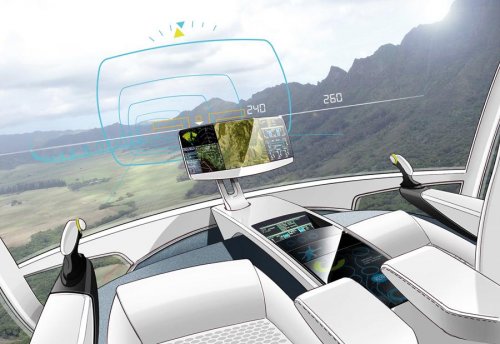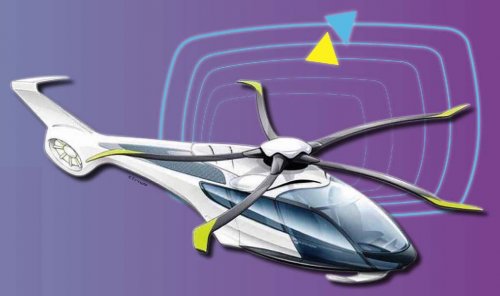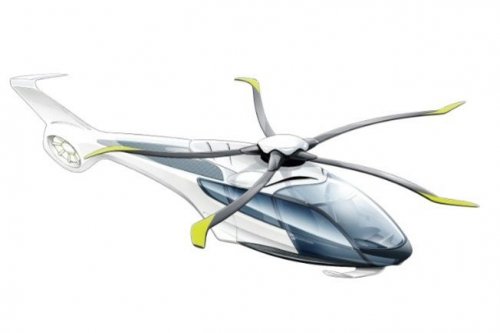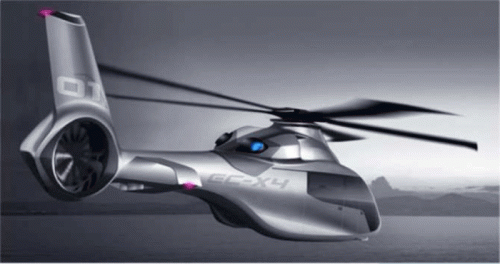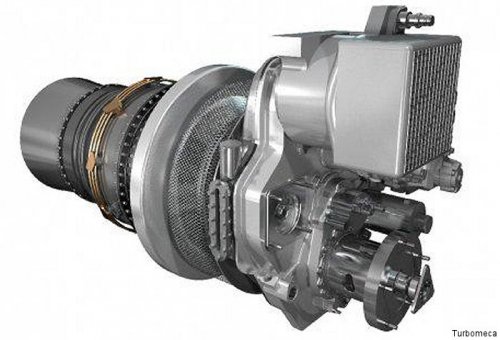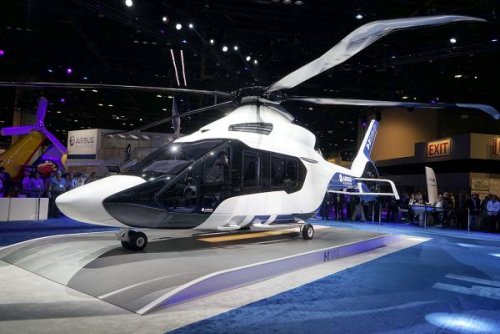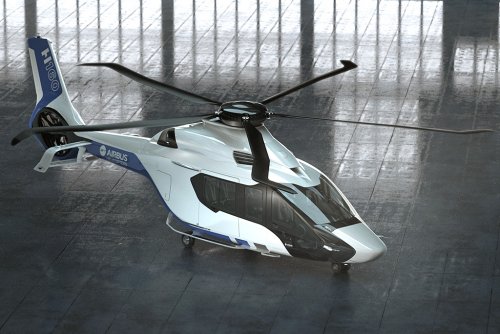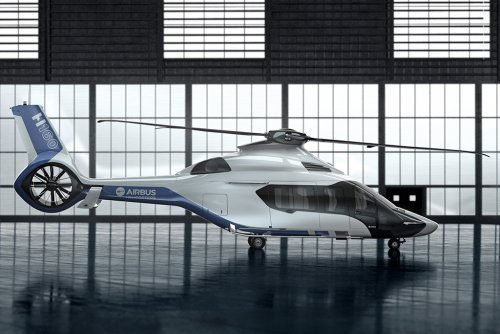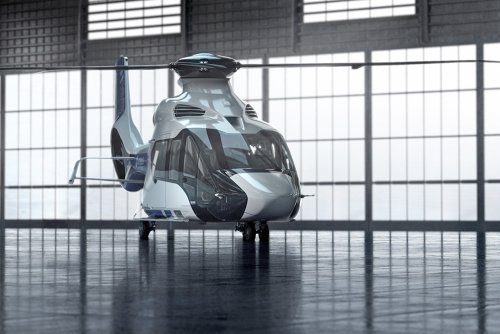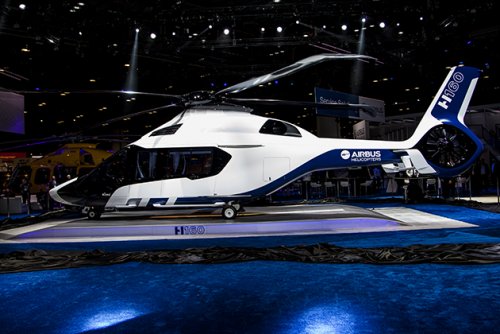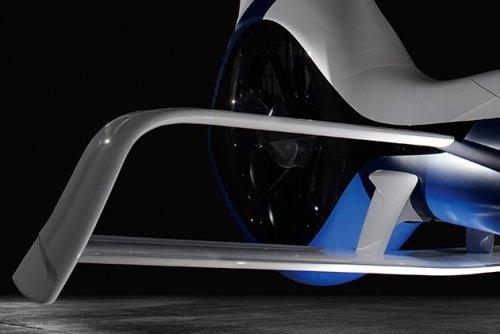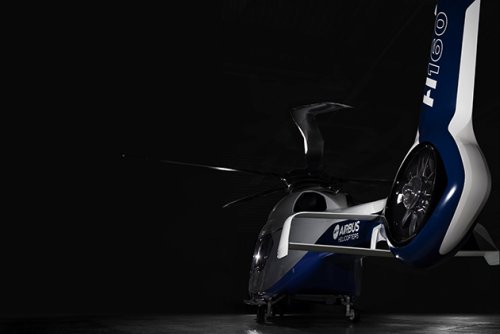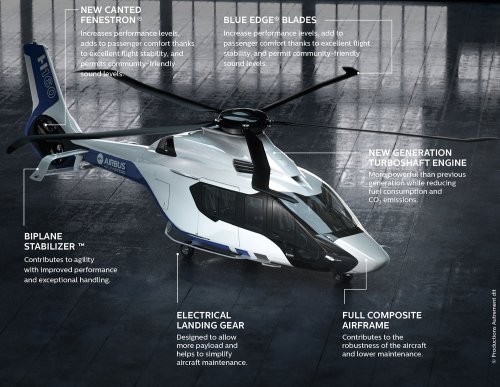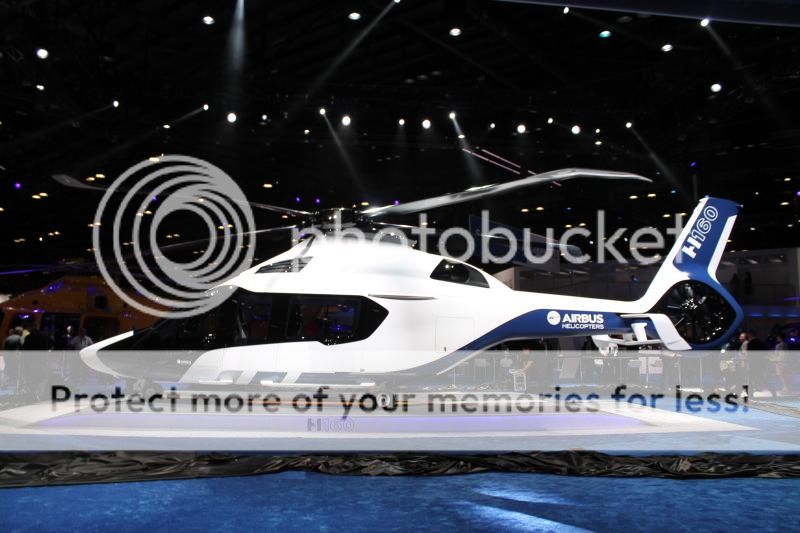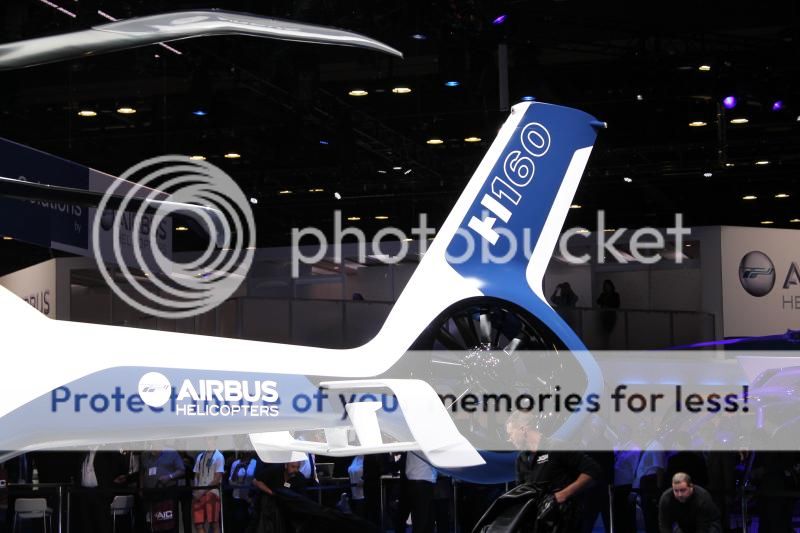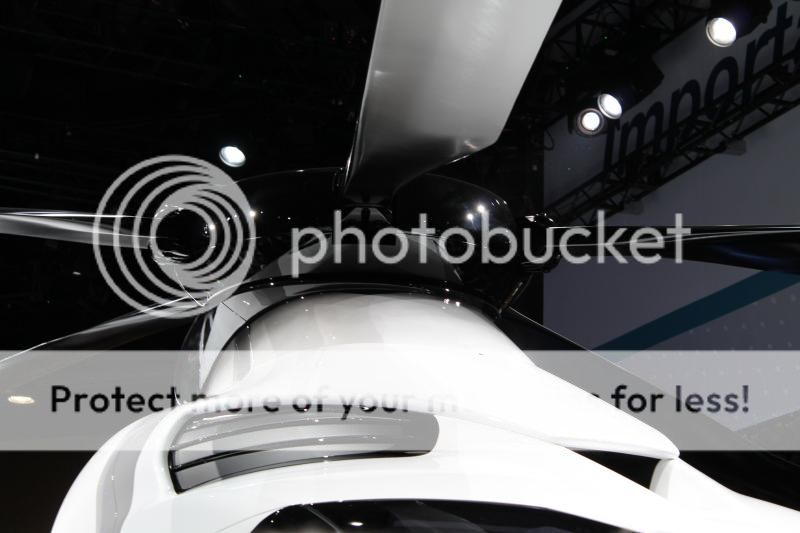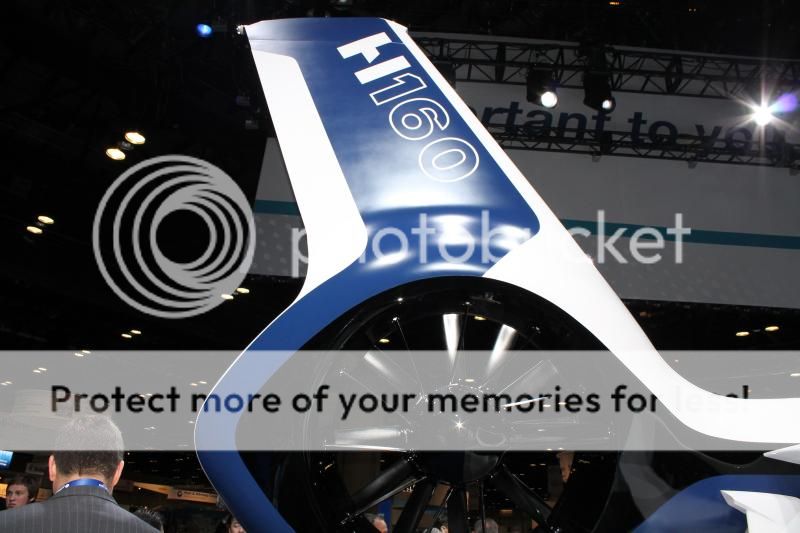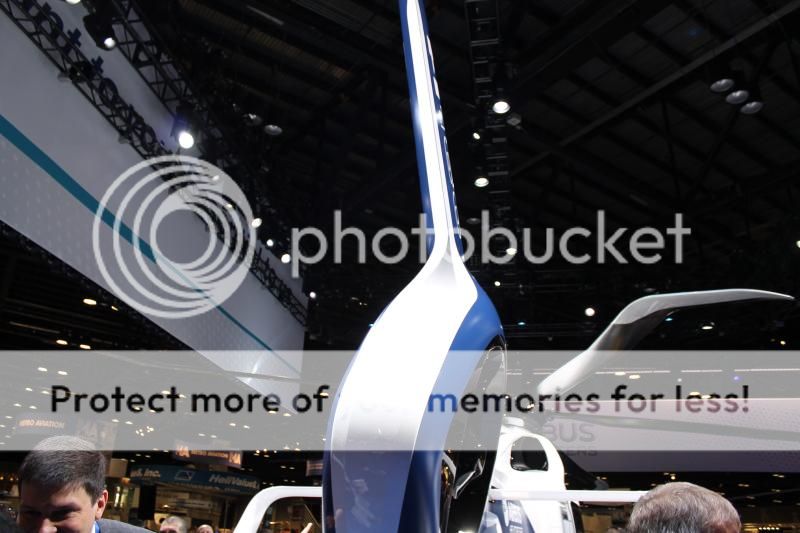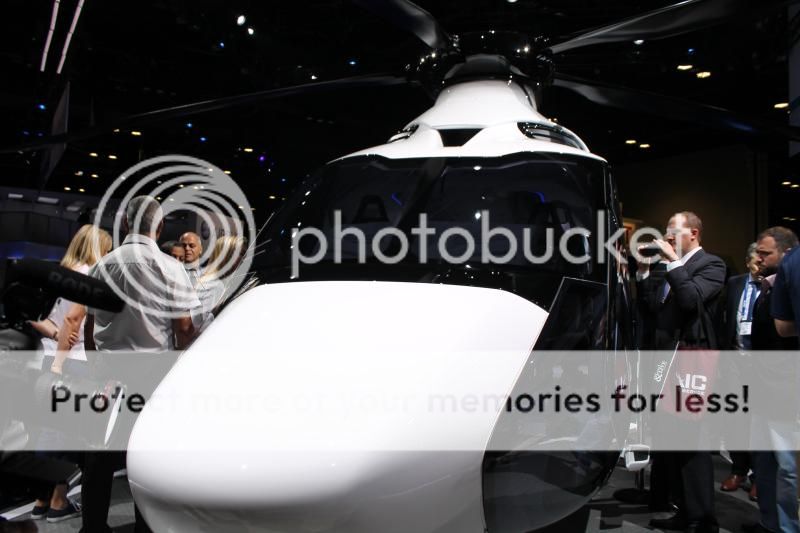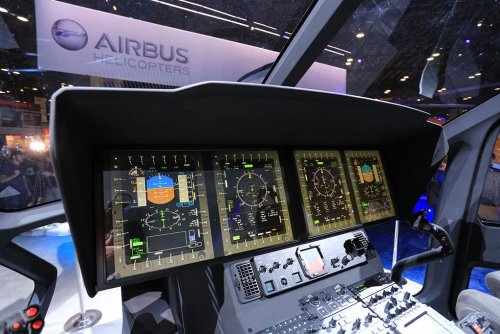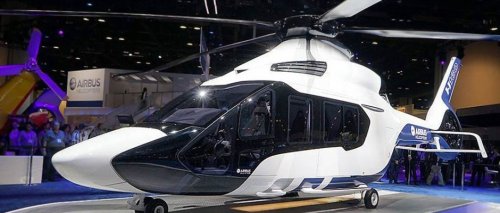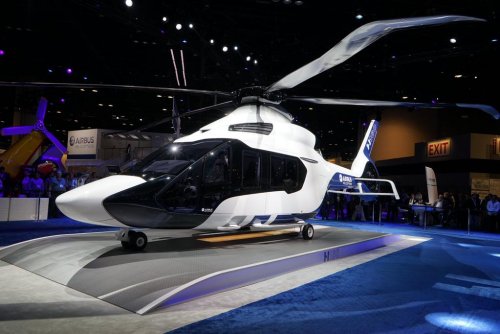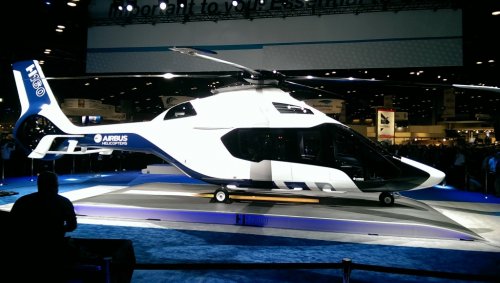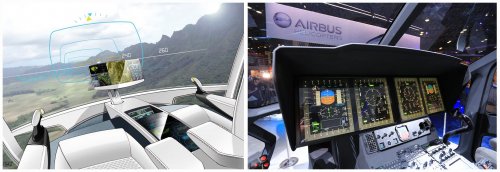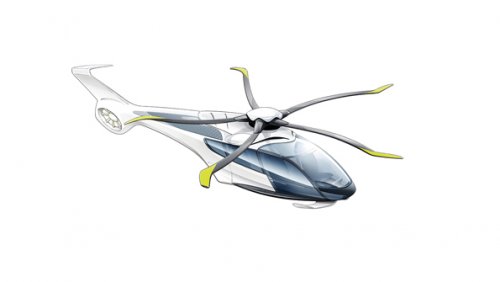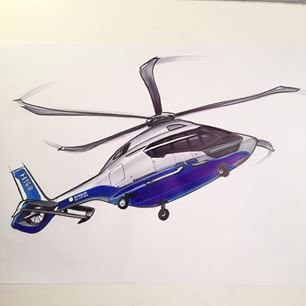Airbus Helicopters unveiled this morning at Heli-Expo 2015 the H160 medium twin, a long-awaited successor for the Dauphin family and designed to lock horns with the AgustaWestland AW139 in the 12-passenger market. Codenamed X4 until now, the clean sheet design features Blue Edge main rotor blades for quieter operation, a canted Fenestron tail rotor for increased payload and the Airbus Helicopters-developed Helionix avionics suite installed on the EC145T2 and EC175. Other innovations include a full composite airframe, a biplane stabilizer–for improved main-rotor efficiency–and an electric landing gear. On display here (Booth 2437) is a full-size mockup. First flight is planned for this year and entry into service in 2018.
For the offshore oil-and-gas mission, the H160 will offer class 1 takeoff performance for 12 passengers and a 120-nm radius of action. In search-and-rescue, hover out of ground effect can be maintained at up to 5,000 feet and range reaches 450 nm with a 20-minute reserve. The smooth cruise speed will be 160 knots, without any counter-vibration system.
Aurélie Gensolen, Dauphin family and X4 marketing product manager, said this is equivalent to the AW139’s performance, “for one metric ton less.” Speaking during a pre-show briefing at company headquarters in Marignane, France, she would not give a precise mtow but said the H160 belongs to the 5.5- to 6-ton category (12,000 to 13,000 pounds). The AW139’s optional mtow is 6.8 tons (just under 15,000 lbs). “Operating costs are directly linked to the weight,” she emphasized. Airbus estimates the H160 will have a fuel burn advantage of 15 to 20 percent over the AW139.
The five Blue Edge blades, already seen on an EC155 demonstrator, will bring a three-decibel improvement over the noise level of a production EC155. The 12-degree canted tail rotor is the first such design with a shrouded Fenestron. It combines the normal anti-torque role and a vertical lift component, which increases payload by some 90 pounds, according to Bernard Fujarski, Airbus’s senior v-p for the X4 program.
The third major aerodynamic feature is the biplane stabilizer. It retains its stabilizing function in forward flight and increases stability in approach, according to its designers. The biplane stab also reduces the masking effect such a surface has on main rotor thrust; the bottom line is another 110 pounds of payload improvement.
The electric landing gear is seen as lighter and safer than its hydraulic equivalent. For safety, the key is eliminating lines full of high-pressure hydraulic fluid below the cabin floor. Zodiac Aerospace is thus supplying the first-ever electric landing gear on a helicopter, AIN understands.
A deicing system is not planned yet, although provisions have been made. Demand is not expected at a compelling enough level anytime soon, as “most oil-and-gas operations with medium twins take place in the Gulf of Mexico and Asia,” Gensolen said. Fujarski added that the weight penalty would be “greater than one passenger.” The AW139 is available with an optional “full ice protection system.”
The Helionix flight deck is similar to that of the EC175, based on four six- by eight-inch displays. A major difference is the return of the overhead panel for engine controls. Cursor-control devices are a key pilot interface and for the mission display a touchscreen will be optional.
The avionics philosophy remains the same as in the EC175, as design engineers have strived to alleviate pilot workload. Another focus in the cockpit’s design is improved exterior visibility, test pilot Olivier Gensse explained. The H160 will be certified for single- and two-pilot operation.
Most composite materials for the airframe are similar to those found on the military NH90. Airbus expects a reduction in maintenance needs and “maximized occupant safety.” An innovation on the rotor hub is the use of thermoplastics for lower-cost manufacturing, reduced weight and, above all, damage tolerance–a crack will propagate very slowly. Airbus Helicopters designers believe the hub has the greatest thickness ever of a thermoplastic part in aerospace. Conventional rotor hubs are metallic, although other Airbus Helicopter models such as the AStar are equipped with composite hubs, which use glass fiber and thermoset resin. The H160’s hub is made from carbon fiber with a thermoplastic resin.
On February 12, the first prototype airframe was still in the paint shop. It was incomplete, missing its main rotor and engines, among other components. Three prototypes–dubbed PT1, PT2 and PT3–will be joined by a pre-production (PS01) aircraft in flight tests. Gensse will be the test pilot aboard PT1, along with two flight test engineers. An EC155 demonstrator has been helping with development of the Blue Edge blades, the stabilizer and the canted tail rotor and will keep supporting the H160 program.
Airbus Helicopters is also introducing comprehensive new ground-test facilities to facilitate development of the H160. These include a dynamic integration testbed and a system integration testbed–respectively the “dynamic helicopter zero” (DHC0) and the “system helicopter zero” (SHC0).
The goal of DHC0 is to ensure the maturity of dynamic systems. These include the flight control system, rotors, drive shafts, gearboxes, engines, etc. “The more we find with DHC0, the easier the flight tests,” said Gary Clark, head of vehicle test and integration. DHC0 also can be seen as a means for fast testing, as a modification is easier to implement on the testbed than it is on a prototype. It is to start running this month and will also be used during the flight test and certification phases. “The first run of DHC0 is as important as the first flight of PT1,” Fujarski emphasized.
All individual components have already been tested. DHC0 is all about integration, Clark said. The program includes engine controls, acoustics, thermal and maintainability trials, among others.
A critical subassembly of DHC0 is the main gearbox, and Airbus claims to have learned lessons from the EC225’s problems. The H160’s main gearbox is a clean-sheet design with a new approach to lubrication redundancy. Two independent systems run 100 percent of the time. In case the main lubrication system fails, the backup provides enough lubrication for about five hours. The backup system has no cooling circuit, being entirely internal. In case both systems fail, the run-dry capability has already been demonstrated to be greater than 30 minutes. This demonstrated duration is expected to be increased through more trials. The rotation speed of the gears has been reduced, too, thus reducing the thermal build-up rate.
For electric and hydraulic systems, SHC0 runs in parallel to DHC0. It is all about anticipating problems for certification and maturity, said Eric Jansonnie, head of system test. Some components are simulated, such as the engines: for example, electric motors enable the generators to run. SHC0 entered into service in January.
Thanks to the new facility, issues have already been found, such as how two of the systems are integrating. Some design teams that were previously distant have been gathered around SHC0 to foster better cooperation. SHC0 is also an important tool–nearly a flight simulator–for flight deck development.
Another tool is the digital mockup. A notable use is to involve customers in the maintainability aspects. For example, retractable footsteps have been integrated in the side fuselage for easier access to the engines. A virtual mechanic could “test” them, thus pre-validating the design.
The MSG-3 process, already used on the EC175 to optimize the maintenance program, is this time involving customers at an earlier stage. Technical documents will be based on images (still or animated) with accompanying text–as opposed to text with accompanying illustrations. A health and usage monitoring system (HUMS) will be standard on the H160.
Airbus wants the H160 to be “a mature aircraft from day one.” The target is to reach a 95 percent availability rate from the first entry into service, up from the EC175’s 90 percent. Operational availability had already been the focus of many efforts on the EC175 program.
The design of the H160 has not been only about technical details, but style has been fostered, too. Guillaume Chielens, who was formerly employed by the PSA Peugeot Citroën automotive group, heads the style bureau. “A driver was the history of the company, but we’ve also had to show it is a new aircraft and give it a strong identity, which could make it as recognizable as a Dauphin,” Chielens explained.
The nose of the H160 creates a link with the EC175, he added. The black “mask” on the livery was created to contribute to modernity. Some lines could still evolve. Flight tests will help designers choose between various fairings at the rotor hub level, for example.
Debates with the rest of the design engineers have been numerous but common ground could often be found, such as with aerodynamicists, Chielens said. “But we can't measure the added value of style,” he pointed out.
Airbus Helicopters plans to begin taking orders for the H160 in 2016.
Operation Restore Share
“Our goal is to restore the 40 percent market share we used to have in this segment,” said Bernard Fujarski, Airbus Helicopters senior v-p for the X4 (H160) program. He defines the medium segment as 4.5 to 7 metric tons (9,900 to 15,400 pounds). Another competitor is thus the Sikorsky S-76D. “We see the AW139 as our main rival but the S-76 fleet is a target for replacement,” said Aurélie Gensolen, Dauphin family and X4 marketing product manager.
Applications will range from offshore to EMS, public services and VIP transportation. Today, the annual market is in the 120- to 150-unit range for medium helicopters. “Over the next 20 years, this is the most promising market in helicopters thanks to growth and replacement,” Fujarski added. Production of the AS365N3+/EC155 Dauphin family will continue “as long as there is demand and it is profitable,” Gensolen said.
A military H160 is seen as doable but there is no plan for it yet.
Power Increase Leaves Turbomeca In, Pratt Out
H160 customers will not have to choose between the Turbomeca Arrano 1A and the Pratt & Whitney Canada PW210E. The H160’s product positioning is different from what it was in 2012 and the power need has increased, Airbus Helicopters explained in February. Pratt & Whitney Canada, which was first selected on the X4 program, decided not to pursue a growth version of the 1,100-shp class PW210E, leaving the 1,100- to 1,300-shp Arrano the only remaining option. Nevertheless, Pratt & Whitney Canada engines will be used for early tests on the dynamic helicopter zero testbed and the first H160 prototype.
X4 Design Evolved Since 2011 Concept
In its definitive form, the X4 is relatively far from the early design unveiled in June 2011. At the time, envisioned was a radically new man-machine interface, including touchscreens, other advanced displays and fly-by-wire (FBW) controls. Former CEO Lutz Bertling often emphasized that the pilot would benefit from enhanced assistance. In a famous quote, he started saying in 2011 that someone taking one of the front seats would miss something–the cockpit.
According to Airbus Helicopters officials, the company is now focusing on those innovations that “bring real value to the customer.” FBW controls, for instance, were eventually deemed unsuited to a medium civil helicopter, as opposed to heavy or military rotorcraft. The weight advantage would have been marginal, for a much more expensive system. “The autopilot already does a lot of things FBW controls would do,” explained Bernard Fujarski, senior v-p for the X4 program.
H160 Inaugurates New Name Scheme
All Airbus Helicopters products are being renamed with an H as the first letter, thus dropping Eurocopter’s EC acronym. Those models still bearing Aerospatiale's legacy AS initials will keep them. In future, single- and twin-engine helicopters will no longer be distinguished by a 0 or 5 at the end of the name. One exception is the AS350 B3e Ecureuil/AStar, renamed H125.
Here are the old names and their new equivalents:
EC120 Colibri is now H120
AS350 B3e Ecureuil/AStar is now H125
AS355 Ecureuil/TwinStar is now AS355
EC130 is now H130
EC135 is now H135
EC145 is now H145
EC155 is now H155
AS365 Dauphin is now AS365
EC175 is now H175
AS332 Super Puma is now AS332
EC225 Super Puma is now H225
An M at the end of the model name will denote a military version.

